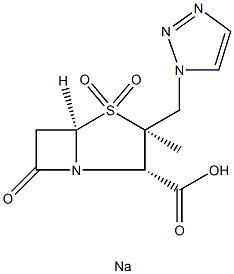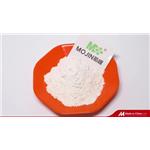Tazobactam sodium is a new triazolylmethyl beta-lactamase inhibitor launched in
combination with the antibiotic piperacillin as tazocilline. Tazobactam sodium is
active against penicillinases and wide spectrum of beta-lactamases. The combination
product tazobactdpiperacillin is effective against a broad range of both
Gram-positive and -negative organisms and is indicated for the treatment of lower
respiratory tract, urinary tract, intra-abdominal, biliary and skin and soft tissue
infections. It is expected to compete against the combination product augmentin
(amoxicillidclavulanate).
White to off-white powder
A β-lactamase inhibitor and antibacterial agent
β-Lactamase inhibitor, used with β-lactam antibiotics to enhance their effect.
Lactamase inhibitor, used with ?lactam antibiotics to enhance their effect
Tazobactam sodium is a beta-Lactamase inhibitor, which is used with penicillinase inhibition studies and beta-lactam antibiotics to enhance their effect. It serves as an antibacterial penicillin derivative, which inhibits the action of bacterial beta-lactamases.
ChEBI: Tazobactam sodium is an organic sodium salt having tazobactam(1-) as the counterion; used in combination with ceftolozane sulfate for treatment of complicated intra-abdominal infections and complicated urinary tract infections. It has a role as an antimicrobial agent, an antiinfective agent and an EC 3.5.2.6 (beta-lactamase) inhibitor. It contains a tazobactam(1-).
A known β-lactam type antibiotic (for example, benzhydryl 2-β-chloromethyl-
2-α-methylpenam-3-α-carboxylate) was used for synthesis of new penicillinic
derivatives.
A solution of 5.00 g of sodium azide in 53 ml of water was added to a solution
of benzhydryl 2-β-chloromethyl-2-α-methylpenam-3-α-carboxylate (5.13 g) in
dimethylformamide (155 ml). The mixture was stirred at room temperature
for 4 h. The resulting reaction mixture was poured into cooled water and the
mixture was extracted with ethyl acetate. The ethyl acetate layer was washed
with water, dried over magnesium sulfate and concentrated to provide 4.87 g
of the benzhydryl 2-β-azidomethyl-2-α-methylpenam-3-α-carboxylate as oil in
93% yield.
To a solution of benzhydryl 2-β-azidomethyl-2-α-methylpenam-3-α-
carboxylate (7.03 g) in a mixture of acetic acid (240 ml) and water (40 ml)
was added potassium permanganate (6.02 g) over a period of more than 1 h.
The mixture was stirred at room temperature for 2.5 h. The resulting reaction
mixture was diluted with ice water. The precipitate was collected by filtration,
and washed with water. The resulting product was dissolved in ethyl acetate
and the solution was washed with an aqueous solution of sodium hydrogen
carbonate and dried over magnesium sulfate. Concentration gave 5.48 g of
the benzhydryl 2-β-azidomethyl-2-α-methylpenam-3-α-carboxylate-1,1-dioxide
in 72% yield.
A 200 mg quantity of benzhydryl 2-β-azidomethyl-2-α-methylpenam-3-α-
carboxylate-1,1-dioxide was reacted with 10 ml of vinyl acetate in a sealed reactor at 100° to 110°C for 30 h. The reaction mixture was concentrated at
reduced pressure. The residue was crystallized with cooled chloroform. The
white crystals of benzhydryl 2-α-methyl-2-β-(1,2,3-triazol-1-yl)methylpenam-
3-α-carboxylate-1,1-dioxide have a melting point 206°-208°C, dec.
Hydrogenation was conducted in 10 ml of ethyl acetate and 10 ml of water at
room temperature for 30 min by using 45 mg of benzhydryl 2-α-methyl-2-β-
(1,2,3-triazol-1-yl)methylpenam-3-α-carboxylate-1,1-dioxide, 15 mg of 10%
palladium charcoal and 16 mg of sodium hydrogen carbonate. The aqueous
layer was separated from the reaction mixture and washed once with ethyl
acetate. The aqueous solution was then purified with an MCl gel, CHP-20P
(product of Mitsubishi Kasei Co., Ltd., Japan). After freeze-drying, there was
obtained an amorphous product of sodium 2-α-methyl-2-β-(1,2,3-triazol-1-
yl)methylpenam-3-α-carboxylate-1,1-dioxide with a melting point 170°C, dec.



